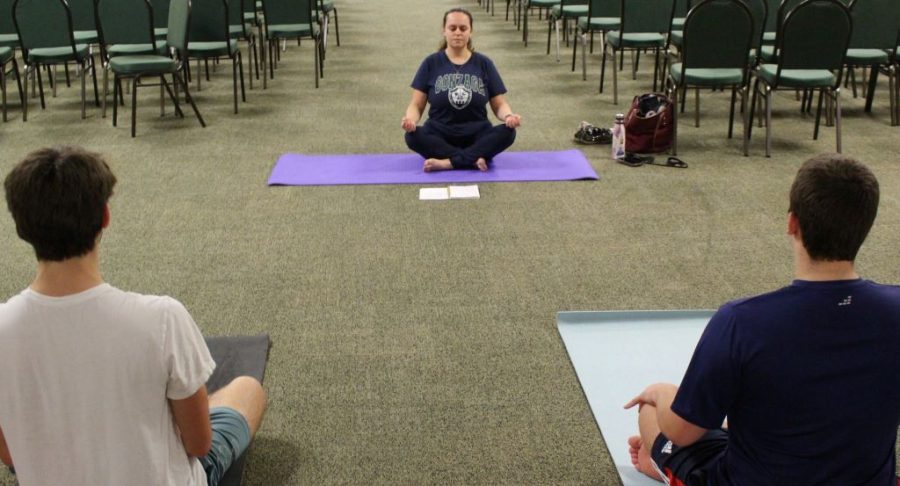Finding a Path to Inner Peace
Ms. Julia Nazarenko conducts a yoga session during the first semester.
May 10, 2022
Breathe in. Exhale. Breathe in. Exhale.
Taking deep breaths is one of many strategies used by people who meditate regularly. Stress, sadness, and other negative emotions can be reduced through meditation. The practice of mindfulness is used by a wide range of people to gain inner peace.
Mrs. Lori Hadorn-Disselkamp, retreat leader for Passionist Earth and Spirit Center, helped lead Trinity juniors on retreats this spring. She said, “Meditation changes mental health positively, and everyone can find their own way to meditate.”
High school students at times may become overwhelmed with the stress associated with classwork and other activities. Learning to meditate can open a new passage to becoming mindful and relieving that stress. Learning how to meditate in the best way for an individual is important.
Trinity theology teacher Mr. Bernie Schum, moderator of the Inner Peace Club, said, “You are not supposed to serve the meditation; it is supposed to serve you.”
Daily meditating can be helpful, but meditation isn’t something that should follow one rule set. Meditation can be formed into methods — long or short, active or passive. An active way of meditating is yoga, which strengthens connections between the body and the mind.
Trinity Spanish teacher Ms. Joulia Nazarenko, moderator of the Yoga Club, said, “Yoga is part of having a mindset of being present and self-aware, and the way you live your life. Align your mind and body with your breathing.”
Yoga uses meditation and breathing techniques to open one’s mind and be comfortable with their body.
Nazarenko said, “Yoga is good for people who are fidgety. It’s hard for me to sit there and meditate, and yoga is a way of meditation for me.”
Nazarenko said there are different degrees of intensity and lengths of meditation. “You could do a couple of poses, and it could take around 10 minutes. But you can also go for an hour and really stretch.”
Meditation is a process, and just like learning in school or playing a sport, it takes time to master.
Hadorn-Disselkamp said, “It takes time, and it starts with awareness. It all starts with breathing. A tip is to not judge yourself too harshly.”
In a study done in 2002, Harvard Gazette staff member William J. Cromie monitored Tibetan monks meditating. Wearing nothing but pants, monks sat in a room that was around 40 degrees Fahrenheit. Freezing wet sheets were placed on the monks’ bare backs. Almost miraculously, steam began to appear from the monks’ backs.
They were producing so much body heat by controlling their breathing and body through meditation, they were drying the sheets. The Buddhist monks believe that there is an alternate reality to tap into.
School and work can be tough and cause stress, but there is a way for everyone to find more relaxation and calmness. Schum said, “If meditation doesn’t work, then it’s the wrong vehicle, but you have to ask yourself, ‘What do I want this to do?’”
Mediation may just open a path to greater happiness.



Dan Zoeller • May 10, 2022 at 2:46 pm
This is a very good article on an important topic. I 100% believe that meditation and/or yoga can improve mental and physical health. They have changed my life for the better.